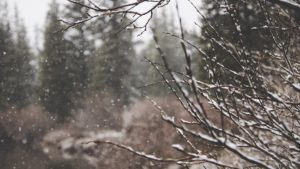
Learn how to avoid potential winter damage to your trees.
Although trees are often strong and resilient, and dormant throughout the winter, they can suffer damage just like anything else from the harsh winter weather. The frost, ice, and dry air of the winter months can take a toll on various trees. If your tree suffers too much during winter, it may continue struggling to survive even in the warmer months. There are a few key winter weather factors that can cause severe winter damage to trees. Read on to learn what weather conditions you should look out for this season.
Low or Fluctuating Temperatures
When temperatures drop below a plant’s tolerance, trees can sustain damage. Temperature fluctuations can cause damages like frost cracks, which can result when the temperatures drop sharply. Sunscald can also occur, and like frost cracks, often appear on the sun-facing side of the tree. These damages are often superficial but can be permanent.
Warm Weather Followed By a Frost
Frost forms when humidity in the air combines with near or below-freezing temperatures. This can be especially harmful if a tree is actively growing. Winter frost damage can show up on trees as brown or black flowers, buds, leaves, or fruit.
The most common time for a tree to be damaged by frost is in late winter or early spring. When occasional warmer weather causes plants to emerge from dormancy, they are vulnerable to unexpected frosts.
Ice Build-Up
During their dormancy, trees can be brittle. If a winter storm brings ice, it may cause winter damage to these vulnerable trees. When this happens, don’t try to remove the ice as this may cause more damage. Maintaining a regular pruning schedule in the fall can help you prevent damage in the winter, but after a storm, you can check for the following:
- Has any portion of the crown been lost?
- Are there broken limbs or branches?
- Are there cracks in the wood?
- Is the tree leaning?
If any of these conditions exist, contact a certified arborist to assess the potential damage to your tree.
Winter Dryness Effects Evergreens
Trees and plants struggle to find moisture as much as we do in the winter. Lower moisture content in the air and soil can create a potentially damaging environment. Evergreens are especially vulnerable to this dryness and can experience winter burn. Winter burn browns evergreen needles and sometimes permanently damages these beautiful trees. Applying an anti-desiccant to evergreen trees can help protect against this winter damage.
If you have any concerns about your tree health through the harsh and unpredictable winter weather, contact Scientific Plant Service today.
Scientific Plant Service Is Your Go-To Source In Landscape Healthcare
Scientific Plant Service, located in Baltimore, is a privately owned corporation, chartered in Maryland in 1957 by Frank J. Burke. We started as a full-service Arborists specializing in the care of shade trees and ornamental shrubs, but today we are a Lawn Care company that is a huge part of the community. From aquatic environments and snow management to deer and mole control, SPS has services tailored specifically for your lawn and landscape.
We offer services in Maryland, Washington, DC, and Virginia, including: Harford, Baltimore, Carroll, Frederick, Howard, Anne Arundel, Montgomery, Prince Georges, Talbot, Queen Anne’s, Calvert counties in MD, as well as Loudoun County, Fairfax County, Arlington, Alexandria, and Falls Church in VA. For more information, contact us online, or call us at 410-321-0970. Be sure to follow us on Facebook, Twitter, LinkedIn, and Pinterest!

